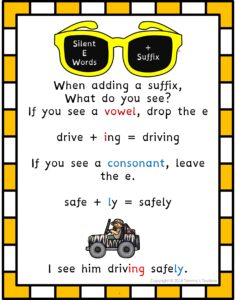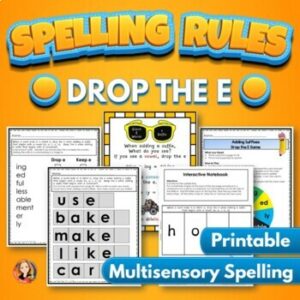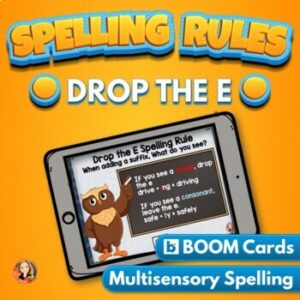Do I drop the e or not?
When adding suffixes, it can be difficult to remember when to drop the e at the end of a word. This is especially true for teachers trying to help their students learn the correct spelling of words. In this blog post, we will explore some of the most common rules for dropping or keeping the final e when adding a suffix to a word. Read on to learn more about this tricky spelling rule!

Drop the E Rule
One of the most common rules for deciding when to drop or keep the final e at the end of a word is known as “the dropping of the final e rule.” According to this rule, if a one-syllable word ends in an unstressed vowel followed by an unstressed consonant (eg. hope, name), you should drop the final e before adding any suffixes that begin with a vowel (eg. hoping, naming).
However, if a one-syllable word ends in an unstressed vowel followed by a stressed consonant (eg. tape, use) you should keep the final e before adding any suffixes that begin with a vowel (eg. taped, used). This helps to avoid confusion between words like “tape” and “tap” or “use” and “us” which have different meanings and pronunciations even though they are spelled differently.
The Silent E Rule
Another commonly used rule for determining when to drop or keep the final e is known as “the silent e rule.” According to this rule, if you are adding a suffix beginning with a consonant (eg. -ness) then you should always drop the final e regardless of how many syllables are in your original word (eg. brave -> braveness). This helps make sure that all suffixes beginning with consonants follow similar spelling patterns so that they can be easily recognized and remembered by students.
Tips for Teaching
- Students should be able to identify base words, prefixes, and suffixes.
- Students should be able to identify consonant suffixes and vowel suffixes.
- Students should know closed, open, and vowel-consonant-e syllables.
- Students should recognize common vowel and consonant suffixes.
- Review consonant and vowel suffixes:
- Use visuals.
- Explicitly teach and practice.
Here is a
free chart to help students remember the rule.

Use word cards or magnetic letters to demonstrate and practice.
- If you don’t drop the e. You end up with two vowels in a row.
- If you do drop the e. The word divides after the first vowel keeping the sound long.
- You need to keep the e when adding a consonant suffix. Otherwise, when you divide between the syllables, it makes a closed syllable and a short vowel.
There is an exception to this rule. If the silent e makes the letter c or g make its soft sound, that e will remain when you add a vowel suffix that begins with a letter other than e, I, or y.
Replace + able = replaceable
Manage + able = manageable
Teaching Spelling Rules
Use multisensory activities to show these concepts. Activities like games, word building, and sorting can help students to see, understand, and apply the rules.
Here are some resources that include hands-on activities, games, and visuals to help you teach the drop-the-e rule.


Remembering when to drop or keep an ending “e” when adding suffixes can be tricky but there are some helpful rules that can help make it easier. With practice and repetition, these rules will become second nature! So don’t hesitate—start practicing today!
Happy Teaching

Look in the
Free Resource Library to get free drop the e worksheets.
To find more information on spelling rules, see these posts.
The Silent E Rule – How to Teach it to Struggling Readers
11 Spelling Rules that Improve Reading
Making the y to i Spelling Rule Fun

 Use word cards or magnetic letters to demonstrate and practice.
Use word cards or magnetic letters to demonstrate and practice.

 Remembering when to drop or keep an ending “e” when adding suffixes can be tricky but there are some helpful rules that can help make it easier. With practice and repetition, these rules will become second nature! So don’t hesitate—start practicing today!
Happy Teaching
Remembering when to drop or keep an ending “e” when adding suffixes can be tricky but there are some helpful rules that can help make it easier. With practice and repetition, these rules will become second nature! So don’t hesitate—start practicing today!
Happy Teaching
 Look in the Free Resource Library to get free drop the e worksheets.
To find more information on spelling rules, see these posts.
The Silent E Rule – How to Teach it to Struggling Readers
11 Spelling Rules that Improve Reading
Making the y to i Spelling Rule Fun
Look in the Free Resource Library to get free drop the e worksheets.
To find more information on spelling rules, see these posts.
The Silent E Rule – How to Teach it to Struggling Readers
11 Spelling Rules that Improve Reading
Making the y to i Spelling Rule Fun 

